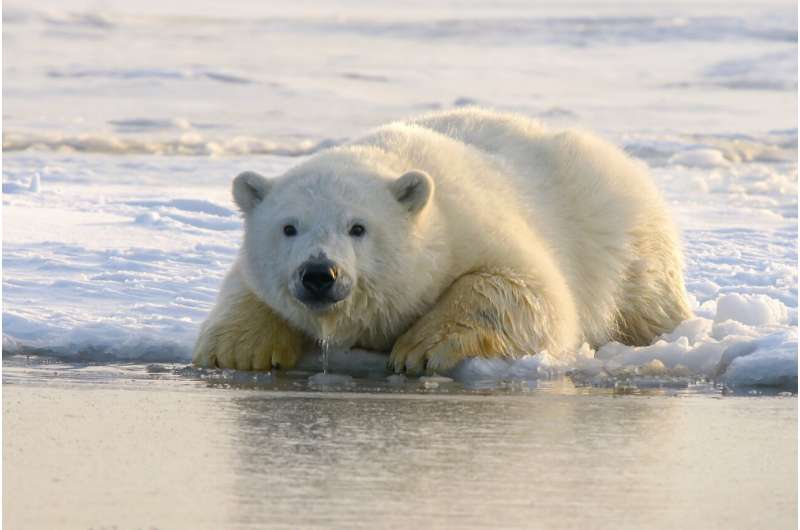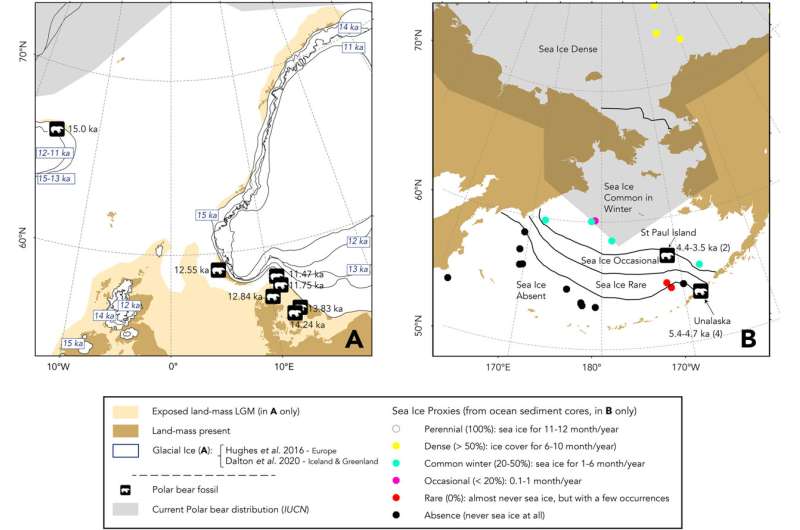September 27, 2023 feature
This article has been reviewed according to Science X's editorial process and policies. Editors have highlighted the following attributes while ensuring the content's credibility:
fact-checked
peer-reviewed publication
trusted source
proofread
Fossil results indicate polar bears survived last global warming deglaciation in Siberian and Canadian refugia

Polar bears are a familiar sight to many through the media as we see evocative images of singular bears floating on isolated ice rafts as they face the harsh realities of climate change shrinking sea ice in the Arctic. Their range is significantly impacted by the presence of perennial sea ice—that which survives at least one summer melt season. Simulations suggest polar ice cover is predicted to disappear during summer months by 2050, meaning this apex predator is increasingly being threatened by extinction due to habitat loss.
The response of this majestic beast to climate change during the last deglaciation is the focus of new research published in Quaternary Science Reviews to determine the effect on their global range and population size.
The Late Glacial, occurring 12,000–15,000 years ago, experienced significant melting of the expansive Scandinavian and North American ice sheets in the northern hemisphere that helped moderate the planet's temperature. This occurs due to ice albedo, whereby incoming solar radiation from the sun melts the "white" ice and exposes more of the comparatively "dark" land and sea, which absorbs the radiation rather than reflecting it back out to space. Consequently, more of the neighboring snow and ice melts, revealing more of the "dark" surface to absorb heat and so the feedback loop continues.
Professor Heikki Seppä, from the University of Helsinki, Finland, and colleagues turned to fossil bones (including forearms, upper hindlimbs and skulls) and teeth previously reported from various Scandinavian countries and islands off the north coast of Russia. These were found in coastal sections as well as archaeological sites, where they likely represent the aftermath of hunting by humans.
The research team determined that polar bears existed on the southwestern margin of the Scandinavian Ice Sheet through the Late Glacial, surviving into the earliest Holocene (the present interglacial over the last 12,000 years). Paleoenvironmental proxies from marine sediments, such as single-celled foraminifera and diatomaceous algae, suggest summer temperatures in the region were 6–10°C.

Continuing into the interglacial, sea ice cover in the arctic 8,000–10,000 years ago is modeled to be approximately comparable to present day. During the Holocene, this supported an exceptional assemblage of polar bears on Zhokhov Island off the coast of Russia, where at least 130 polar bear remains have been found, and is inferred to represent the maximum perennial sea ice extent at this time.
This archaeological site also offers insights into the hunter-gather human population migrating between here and the Siberian mainland, with polar bears and reindeer being a substantial component of their diet.
However, the warmest period of the Holocene, the Holocene Thermal Maximum between 5,000–9,000 years ago experienced polar temperatures 1.5–2.5°C higher than today and coincides with a notable absence of polar bears in the fossil record of this region.
Instead, the research team note that polar bear remains from adjacent areas radiocarbon-dated to 5,000–6,000 and 8,000–9,000 years ago are indicative of these mammals seeking out cold refugia which were persistently cooler than surrounding environments, located near the East Siberian Sea, northern Greenland and the Canadian Archipelago.
Fossils found on Alaska's Aleutian Islands and Pribilof Islands likely represent the southernmost extent of polar bears during these considerably warmer intervals, and the researchers deduced that the surrounding Bering Sea only experienced sea ice during winter, if at all.
Therefore, the research team suggest that the polar bears found ways to survive at the seasonal limits of sea ice, seeking out seal breeding grounds to hunt their prey, evidenced by the preservation of ringed seal fossils in association with polar bears on these islands.
Yet, as sea ice-limited populations of seals are also likely to decline, polar bears turning to alternative food sources is not something that current researchers have observed to sufficiently support their continued survival, nor is terrestrial food nutritionally complete, as seen in declining polar bear body mass.
While a general cooling trend and expanding sea ice has been predominant over the last 4,000 years, the effects of anthropogenic warming pivoting this trend to exacerbate polar bear habitat decline may see Siberia and Canada once more become refugia for these majestic creatures. This in turn necessitates further resources to help protect such refugia in the decades to come to ensure they too survive.
More information: Heikki Seppä et al, Polar bear's range dynamics and survival in the Holocene, Quaternary Science Reviews (2023). DOI: 10.1016/j.quascirev.2023.108277
Journal information: Quaternary Science Reviews
© 2023 Science X Network




















